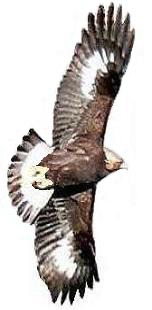(Buteo lineatus)
Migration Timeframe:
Red-shouldered Hawk juveniles move before the adults.
Migration starts by mid-September and slowly increases
through to the end of the month. In October, numbers
continue to increase, peaking toward the end of October and
beginning of November. Numbers decrease fairly dramatically
through November and rare individuals may be observed in
December.
|
Years |
Peak Week |
Avg |
|
2002-2007 |
Oct 20-26 |
392 |
|
Year |
Peak Week |
Count |
|
2008 |
Oct 27-Nov 02 |
275 |
|
Year |
Earliest
Obs |
Count |
Year |
Latest
Obs |
Count |
|
2002-2007 |
Sep 18 2004 |
2 |
2002-2007 |
Nov 24 2006 |
2 |
|
2008 |
Oct 01 |
2 |
2008 |
Nov 21 |
5 |
Where to Watch:
Most of the time the best locations to
watch for Red-shouldered Hawks is starting at "Sharpie Alley" and
moving northward to find their flight line (usually along with the
other buteos). They are often seen soaring and kettling with
Redtails. Note, however that Shoulders usually prefer to move (migrate) on
less windy days. They seem not to like fighting into a strong head
wind as much as the Redtails.
High Counts:
The 2008 yearly total for Shoulders was disappointing with just 575
tallied...and no new records were set for this species.
|
1-Year |
Count |
1-Month |
Count |
|
2007 |
1,134 |
Oct 2005 |
910 |
|
1-Day |
Count |
1-Hour |
Count |
|
Oct 23 2005 |
393 |
Oct
23 2005 |
151 |
Yearly Totals:
The 2008 yearly total was significantly less than both the 10-Year
and 5-Year averages. This is a change from the steady increase in
Red-shoulder numbers since the late 90's.
(averages are based on 1998-2007 and 2003-2007 counts).
|
Year |
Count |
Year |
Count |
Year |
Count |
|
1995 |
140 |
2000 |
315 |
2005 |
1,028 |
|
1996 |
265 |
2001 |
566 |
2006 |
1,090 |
|
1997 |
141 |
2002 |
496 |
2007 |
1,134 |
|
1998 |
319 |
2003 |
884 |
2008 |
575 |
|
1999 |
438 |
2004 |
559 |
2009 |
N/A |
|
10-Yr Avg |
5-Yr Avg |
|
683 |
939 |
Interesting Facts:
-
Northern
populations, including those breeding and/or summering in
Canada, are migratory. They move short to moderate
distances, staying within the North American continent.
This includes areas from Missouri to Indiana, eastern Texas
and from North Carolina to Florida (rarely south of central
Florida). name comes from their very thin, exposed lower legs
-
Rare in
the winter time in Ontario, however there are reports of
Shoulders “wintering” in Toronto and other locations in
Ontario.
-
The
“Eastern” bird (Buteo lineatus lineatus) is the largest of
the Red-shoulders.
-
Sexes
are similar, except females average larger, with some
overlap.
